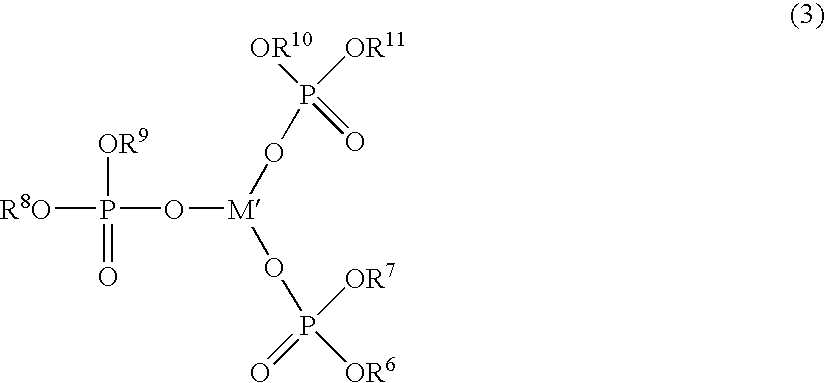Resin composition and resin molded product
a technology of resin composition and resin molded product, which is applied in the direction of organic chemistry, organic chemistry, chemical apparatus and processes, etc., can solve the problems of resin material deterioration, poor compatibility between, and chemical resistance of aromatic polycarbonate resin, etc., and achieves excellent hydrolysis resistance, low cost, and low cost
- Summary
- Abstract
- Description
- Claims
- Application Information
AI Technical Summary
Benefits of technology
Problems solved by technology
Method used
Image
Examples
production example 1
[0110]A 100-L stainless steel reactor equipped with a stirrer, a distillation tube, a heater, a pressure gauge, a thermometer and a pressure-reducing device was charged with 101.5 parts by weight of 1,4-cyclohexanedicarboxylic acid (ratio of trans-isomer to cis-isomer: 96:4), 87.0 parts by weight of 1,4-cyclohexanedimethanol (ratio of trans-isomer to cis-isomer: 69:31) and 0.005 part by weight of a 6 wt % butanol solution of tetra-n-butyl titanate, and an interior of the reactor was then purged with a nitrogen gas. While sealing the interior of the reactor with a nitrogen gas, an inside temperature of the reactor was raised to 150° C. over 30 min, and then raised from 150° C. to 200° C. over 1 hr. Next, the inside temperature of the reactor was held at 200° C. for 1 hr to subject the contents of the reactor to esterification reaction. Thereafter, the inside temperature of the reactor was raised from 200° C. to 250° C. over 45 min while gradually reducing an inside pressure of the re...
production example 2
[0111]The same procedure as defined in Production Example 1 was conducted except that the amount of 1,4-cyclohexanedimethanol charged was changed to 87.9 parts by weight, and the polycondensation reaction time was changed from 3.7 hr to 4.5 hr. As a result, it was confirmed that the obtained product had an intrinsic viscosity of 0.841 dL / g, an end carboxylic acid concentration of 2.7 eq / t, a YI value of 13.8 (as pellets) and a melting point of 219.6° C.
production example 3
[0112]The same procedure as defined in Production Example 1 was conducted except that the amount of 1,4-cyclohexanedimethanol charged was changed to 88.6 parts by weight, the absolute pressure inside of the reactor was changed to 0.1 kPa, and the reaction time after raising the reaction temperature to 250° C. was changed to 3.6 hr. As a result, it was confirmed that the obtained product had an intrinsic viscosity of 0.957 dL / g and an end carboxylic acid concentration of 12 eq / t.
PUM
| Property | Measurement | Unit |
|---|---|---|
| pressure cooker tester | aaaaa | aaaaa |
| yellowness index | aaaaa | aaaaa |
| kinematic viscosity | aaaaa | aaaaa |
Abstract
Description
Claims
Application Information
 Login to View More
Login to View More - R&D
- Intellectual Property
- Life Sciences
- Materials
- Tech Scout
- Unparalleled Data Quality
- Higher Quality Content
- 60% Fewer Hallucinations
Browse by: Latest US Patents, China's latest patents, Technical Efficacy Thesaurus, Application Domain, Technology Topic, Popular Technical Reports.
© 2025 PatSnap. All rights reserved.Legal|Privacy policy|Modern Slavery Act Transparency Statement|Sitemap|About US| Contact US: help@patsnap.com



